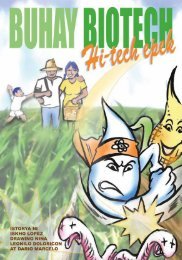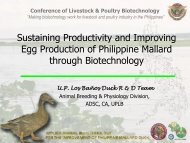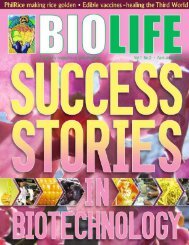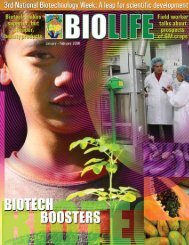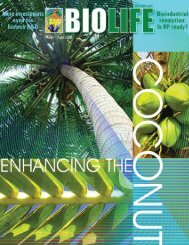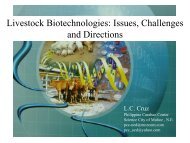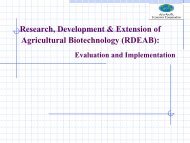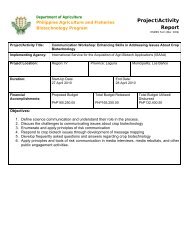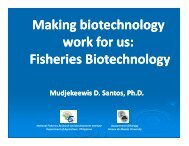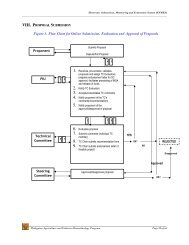Download PDF - SEARCA Biotechnology Information Center
Download PDF - SEARCA Biotechnology Information Center
Download PDF - SEARCA Biotechnology Information Center
You also want an ePaper? Increase the reach of your titles
YUMPU automatically turns print PDFs into web optimized ePapers that Google loves.
18 BIO LIFE January – March 2005<br />
by 23 centavos than the non-Bt, but cash<br />
costs were higher. The net income per kilo Table 3. Prices, Net Income and Returns to Labor and Management,<br />
showed a difference of 10 centavos for the<br />
407 Bt and Non-Bt Corn Farms, Philippines, 2003-2004<br />
Bt corn and had an advantage of more than CORN TYPE/ Cost of Net Cash Return to<br />
P1/kg in returns over the non-Bt varieties. LOCATION Price Production Income Costs Labor and<br />
Yorobe also observed that Bt corn received<br />
Pesos/kg Management<br />
a premium price in the market due to better<br />
(1 - 4)<br />
quality and less impurities. He said that Bt Bt<br />
corn farmers, particularly in Camarines Sur Camarines Sur 8.00 5.86 2.14 5.38 2.62<br />
and Bukidnon, received premium prices by Bukidnon1st crop 6.86 5.99 0.87 5.27 1.59<br />
as much as P1.61/kg during the second crop. Bukidnon 2nd crop 9.80 10.08 (0.28) 9.30 0.50<br />
Many farmers traced this to the fact that Bt South Cotabato 8.83 4.61 4.22 4.29 4.54<br />
corn kernels and ears were bigger and Isabela 8.92 4.27 4.66 4.10 4.82<br />
cleaner with uniform sizes.<br />
All locations 8.82 4.97 3.85 4.66 4.16<br />
In sum, (Table 4) (Table 6 in the study)<br />
the increase in total revenue of Bt corn farms Non-Bt<br />
amounts to P14,849 per hectare, with savings<br />
of P168/hectare in insecticide expendi-<br />
Bukidnon 1st crop 6.66 5.31 1.36 4.30 2.36<br />
ture. Although the seed costs were twice Bukidnon 2nd crop 8.19 5.16 3.02 4.23 3.96<br />
higher than the non-Bt varieties, the study South Cotabato 8.11 4.92 3.20 4.35 3.76<br />
showed that the profit advantage almost Isabela 8.68 4.77 3.90 4.52 4.16<br />
doubled. The benefit cost ratio of 2.014 All locations 7.71 5.20 2.51 4.56 3.15<br />
shows the better performance of Bt corn. Source of data: ISAAA Corn Survey, 2003-2004<br />
With the estimated area planted to Bt corn<br />
Bicol 6.84 6.10 0.74 5.66 1.18<br />
in 2003-2004 at 10,769 hectares, Table 5<br />
(Table 13 in the study) shows the results of<br />
the distribution of benefits. The estimates are Table 4. Income and Cost Advantages of Bt corn Farm Adopters,<br />
presented by region owing to wide differences<br />
in agro-climatic conditions and man-<br />
407 Bt and non-Bt Corn Farmers, Philippines, 2003-2004<br />
agement practices across regions, Yorobe CROPPING/ Increase Pesticide BC Ratio<br />
explained.<br />
LOCATION in Total Application Additional Additional (total<br />
Variations in yield per hectare and cost<br />
Revenue Savings Seed Cost Profit returns/<br />
per unit were evident in the results. With a<br />
(Pesos/hectare)<br />
total cost)<br />
larger area planted to Bt corn and a higher 1st Cropping<br />
cost reduction per unit, the net benefit to Camarines Sur 13,833.00 179.00 2,202.00 4,462.00 1.363<br />
farmers was largest in Northern Luzon, with Bukidnon 7,210.00 (78.00) 2,626.00 (701.00) 1.201<br />
P20.95 million. Farmers in other regions had<br />
lesser benefits because of the smaller area 2nd Cropping<br />
planted to Bt corn and minimal reported cost Bukidnon (710.00) 47.00 2,649.00 (6,283.00) 1.365<br />
reduction per unit of production.<br />
Isabela 8,680.00 132.00 1,741.00 7,910.00 2.285<br />
Farmers in Northern Mindanao had South Cotabato 14,046.00 446.00 2,289.00 7,669.00 1.991<br />
negative benefits as more costs were reported<br />
on fertilizers, chemicals and hired labor.<br />
Farms in these areas also experienced Source of data: ISAAA Corn Survey, 2003-2004<br />
drought and stalk rot infestation.<br />
All locations 14,849.00 168.00 2,047.00 10,132.00 2.014<br />
After one year of commercialization, the<br />
net benefit to farmers in the aggregate<br />
amounted to P46.44 million. This was estimated<br />
using the area planted to Bt and the<br />
reduction in per-unit costs. The estimated<br />
gross revenue by the seed company was<br />
P43.48 million, which includes the cost of<br />
the technology. These benefits, Yorobe underlined,<br />
represent the direct and immediate<br />
impact of the corn industry and now cover<br />
the indirect effects with other industries, like<br />
livestock, where corn is a big demand.<br />
Farmers’ profile<br />
It is interesting to note that there are<br />
some noticeable differences observed in<br />
the characteristics between Bt and non-Bt<br />
After one year of<br />
commercialization, the<br />
net benefit to farmers in<br />
the aggregate amounted<br />
to P46.44 million.<br />
This was estimated<br />
using the area planted<br />
to Bt and the reduction<br />
in per-unit costs.<br />
corn farmers, which could be important factors<br />
in the adoption of the new technology.<br />
(Table 6)<br />
(Table 1 in the study). It shows that Bt<br />
corn farmers were relatively younger (45.38<br />
against 46.77 years), and have larger farms<br />
((4.04 hectares against 2.47 hectares) than<br />
their non-Bt counterparts. The area planted<br />
to Bt corn was also larger (2.64 hectares)<br />
compared to non-Bt corn (1.64 hectares). Bt<br />
corn farmers were also better-educated<br />
(about 10 years of formal schooling against<br />
the non-Bt users’ eight years); they earned<br />
more—over P2,000 a month—from other<br />
sources besides farming, and this is an important<br />
source of capital for farming opera-




